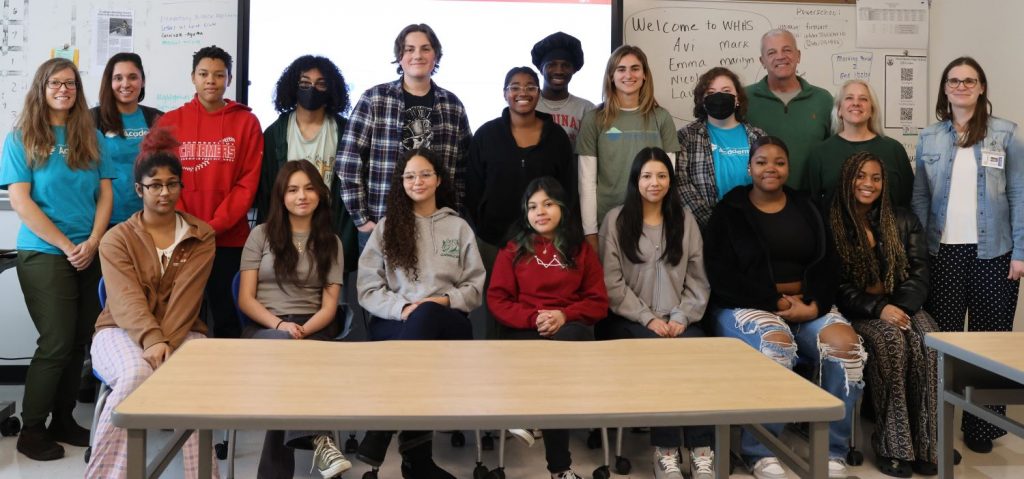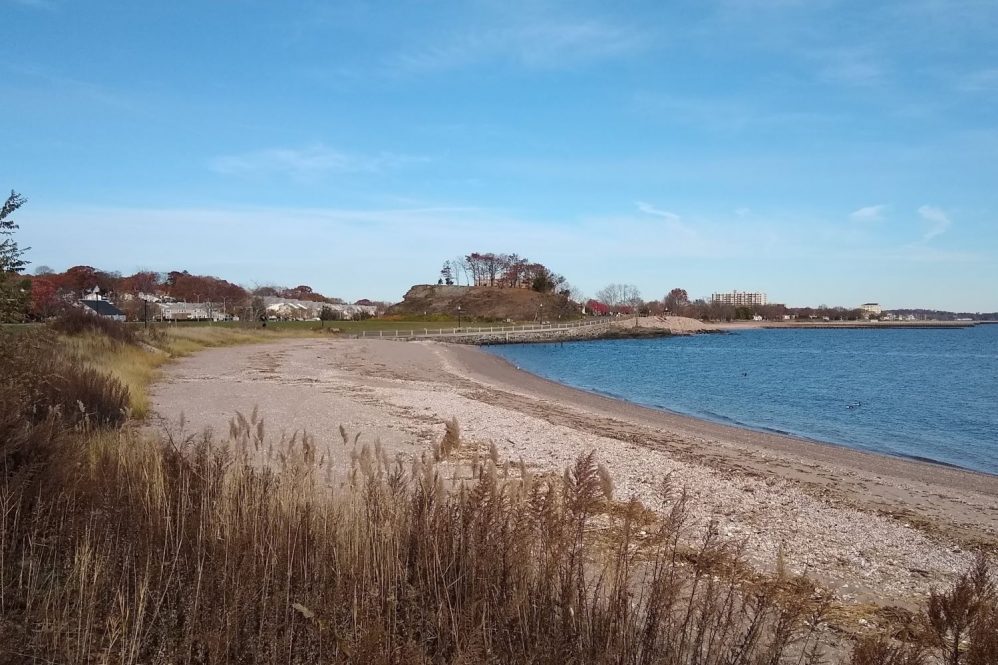Connecticut’s shoreline is in trouble. According to projections, the state may lose up to 24,000 acres of land because of rising sea levels by 2080. A unique program connects Connecticut high schools with an interdisciplinary UConn team to not only tell this story, but also help identify potential solutions.
Fourteen West Haven High School digital media students were recently selected to participate in UConn’s Eco-Digital Storytellers program.
Through the Eco-Digital Storytellers program, which is backed by a $1.35 million grant from the National Science Foundation (NSF), UConn is providing funding and technical support to select Connecticut high school students so they can create community-focused digital-media environmental-action projects.
“This program supports school teams as they advocate for a possible solution or action to address a socio-environmental challenge or opportunity in their community, and uses interactive and multimedia storytelling to envision an environmental future and engage decision makers,” say Laura Cisneros, associate Extension professor and director of UConn’s Natural Resources Conservation Academy. She is also the principal investigator on the NSF grant that funds Eco-Digital Storytellers.
Eco-Digital Storytellers is a joint program including UConn’s College of Agriculture, Health and Natural Resources, the Neag School of Education, and the School of Fine Arts. Over the course of the three-year grant, the program aims to serve 270 high school students across 54 school pods. Each “pod” includes a small group of high school students and their teacher, as well as UConn undergrads who serve as near-peer mentors.
For their Eco-Digital Storytellers work, the West Haven students will focus their project on West Haven’s Shoreline Resilience and Eco-Restoration Project.

“This partnership is a win for my students on so many levels,” says West Haven High School digital media and journalism teacher Jennifer Cummings. “They are getting hands-on experience with UConn’s Departments of Natural Resources and the Environment, Digital Media and Design, and Extension while helping to publicize an important environmental project that is close to home.”
Working with UConn faculty with a variety of disciplines allows the students to translate complex scientific topics into engaging, creative stories. The UConn team is also hopeful this project with help diversify the voices of people telling environmental stories. Both STEM and digital media and design fields have historically been dominated by a white male perspective.
“We’re really thinking about narrative structures as a way for people to express their identities and their thoughts and actions about environmental issues and then using technology to support those narratives,” says Anna Lindemann, associate professor of motion design and animation and one of the lead faculty members associated with the project. “Empowering college students to be mentors who will then inspire high school students is one of the really exciting and novel parts of this project.”
The West Haven Shoreline Resilience and Eco-Restoration Project will restore 1.5 acres of public shoreline to native coastal plant and dune habitat and enhance public access to environmental education and passive recreation in a highly trafficked stretch of the shoreline across from Old Grove Park.
“We feel very fortunate that the students have chosen to focus their project on the Shoreline Restoration project because their work will help us to build awareness for it while helping to make a difference in their community,” said Shoreline Restoration co-leads Mark Paine, director of Parks and Recreation for the City of West Haven, and Marilyn Wilkes, vice president of the Land Trust of West Haven.
West Haven High School students are collaborating with the Shoreline Restoration Committee and a multidisciplinary UConn team of seven professors and two undergraduate students to create a series of videos about the project. They hope their videos will bring more attention, support, and funding to the Shoreline Restoration initiative.
“The first time I heard about the Shoreline Restoration project was in my digital media and journalism class,” says Agatha Lima-Freitas, a senior at West Haven High School. “I feel connected to the project because it’s so close to the school. I adore journalism, and I also participate in the gardening club at my school. Those three things come together for this project. I also joined because I have little brothers, and I would love to take a walk with them near the beach in a beautiful and clean environment. I want them to have a special place in our town.”
Over the course of the school year, the UConn team will teach the students how to engage in environmental storytelling, using geospatial technology and digital media tools as vessels to convey their messages. They will be taught how to use a mapping application, called ArcGIS StoryMaps, to create interactive online narratives using maps and digital media. Students will also learn basic digital media and design skills, such as video and animation, to share engaging stories about the project.
“With this project, we can help West Haven students with an environmental project that they’re passionate about and that will help to improve their community,” explain Emma Dutil and Avi Obie, both UConn students and eco-digital storyteller mentors for the program. “We are excited to be working with them and can’t wait to see their final product!”
The students will showcase their digital projects at a professional event hosted by the Connecticut Science Center in May 2024.
This work relates to CAHNR’s Strategic Vision area focused on Fostering Sustainable Landscapes at the Urban-Rural Interface.
Follow UConn CAHNR on social media



